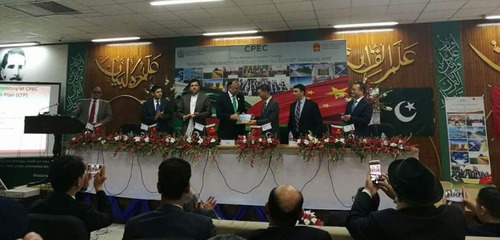1. Pakistan-China Economic Corridor
Pakistan vigorously works with China to update the China-Pakistan Economic Corridor (CPEC), a pivotal part of China’s Belt and Road Initiative (BRI). This refurbishment goal aims to improve Pakistan’s infrastructure, stimulate its economy, and boost regional connectivity. By investing in CPEC, Pakistan looks to reinforce its financial ties with China while positioning itself as a key player in regional trade. The concentration of this article is on the ongoing modernization of CPEC, its economic advantages, infrastructure progress, and the strategic partnership between Pakistan and China.
2. Economic Impact of CPEC Modernization
. By enhancing infrastructure, advancing trade routes, and generating job opportunities, CPEC aims to drive Pakistan’s economic growth.
3. Key Economic Benefits
a.Increased Foreign Investment:
The modernization of CPEC is likely to attract overseas investors to Pakistan, accelerating the nation’s economy.
b.Job Creation:
As infrastructure projects advance, they are anticipated to produce numerous job possibilities for local communities.
c.Improved Trade Routes:
CPEC will decrease transportation costs and time, making trade more effective and boosting Pakistan’s export potential.
4.Infrastructure Development Under CPEC
Infrastructure progress is a cornerstone of CPEC refurbishment. The initiatives include the construction of highways, railways, ports, and energy infrastructure, all of which are critical for enhancing Pakistan’s connectivity.
5.Modernizing Road Networks
a.Karachi-Lahore Motorway Upgrade:
Upgrading this major highway is essential for improving trade and transportation efficiency.
b.Gwadar Port Development:
Enhancing connectivity to Gwadar Port will transform it into a major hub for international trade. However, complex issues remain regarding development in the Balochistan region.
6.Advancements in Railway Infrastructure
a.ML-1 Railway Project:
The Main Line-1 railway upgrade is a significant CPEC project that will improve freight and passenger transport across Pakistan, though funding issues create uncertainty.
b.Energy Projects: A Pivotal Component of CPEC
Energy projects are central to achieving CPEC’s modernization goals. By tackling Pakistan’s energy needs, CPEC aims to encourage industrial growth and better people’s quality of life.
7.Renewable Initiatives Show Promise
Solar and Wind Power Projects:
These endeavor to lessen Pakistan’s reliance on imported fuels while promoting eco-friendliness. Hydropower Development: Undertakings like the innovative Karot and efficient Suki Kinari dams are intended to furnish clean, dependable energy.
8.Thermal Power Projects Seek Improvement
Efficiency Enhancements: Modernizing present thermal power facilities will boost their proficiency and decrease emissions.
9.Challenges in Optimizing CPEC
While optimizing CPEC offers many benefits, it also faces obstacles that must be addressed for successful execution.
a.Financial Obstacles Loom Large
Securing Funding: Steady funding is indispensable for timely project completion. Managing Costs: Delays in execution can lead to increased expenses, which must be capably managed.
b.Security Concerns Demand Attention
Ensuring Project Security
: Maintaining security in regions with ongoing conflicts is critical for progress. Addressing Local Opposition: Engaging communities and resolving their issues is important for smooth implementation.
10.Technology’s Role in CPEC Optimization
Technology performs a vital function in successfully optimizing CPEC. Advanced technologies are utilized to improve proficiency and ensure sustainability in execution.
a.Intelligent Infrastructure Takes Shape
IoT and Smart Grids:
The use of IoT technology and smart grids in energy projects ensures efficient energy distribution. GIS and Digital Mapping: These technologies are applied to plan and execute infrastructure projects with precision.
Sustainable Construction Methods Gain Traction
Prefabrication: Prefabricated components reduce construction time and costs, making it easier to meet deadlines. Use of Sustainable Materials: Emphasizing sustainable materials ensures the long-term durability of the infrastructure.
11.Strategic Importance of CPEC for China
a.A Signature Project of BRI
CPEC represents the flagship corridor of China’s sprawling Belt and Road Initiative, envisioned to broaden trade routes interlinking Asia, Africa, and Europe.
b.Quest for Energy Security
By financing infrastructure development in Pakistan, the initiative additionally aims to furnish China with a reliable route to import oil and natural gas from Persian Gulf nations, lessening reliance on vulnerable Malacca Strait.
12.Modernizing CPEC: A Transformation in the Making
It will significantly enhance regional connectivity, catalyze sustainable progress, and position Pakistan as a pivotal trade hub within the region.
a.Prioritizing Environmental Sustainability
Future CPEC initiatives will emphasize preserving the environment to guarantee financial growth does not undermine ecological integrity.
b.Ensuring Local Benefits
For the project to achieve long-term success, it is crucial to ensure CPEC-driven development filters down to uplift living standards across Pakistani communities.
c.Extending Reach into Central Asia
With prudent planning, CPEC can potentially stretch beyond Pakistan, tying the Central Asian republics into a broader trans-regional trade network and economic bloc.
Pakistan’s strategic choice to jointly modernize CPEC with China is expected to completely reshape its economy. By addressing challenges and capitalizing on new technologies, both nations can safeguard CPEC’s preeminent role in catalyzing inclusive growth and development throughout the region. The modernization drive will bolster Pakistan’s infrastructure, energy sector and position it as a key node within global commerce.
Also Read:




